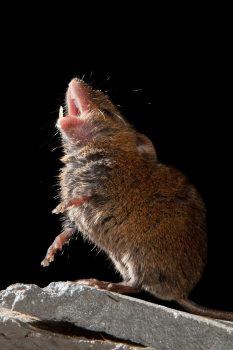Carl Zimmer in The New York Times:
 High in the mountains of Central America lives a little known creature called Alston’s singing mouse. This rodent, which spends its life scuttling around the floor of the cloud forest, may not seem like it has much to tell us about ourselves. But the mouse produces remarkable songs, and researchers have discovered some profound similarities to our own conversations. This ability may be linked evolutionarily to the ancient roots of human language. Scientists have struggled for over a century to work out the origin of language in our mammal ancestors. “Until very recently there was still this belief that human speech and mammalian vocalizations are two completely different things,” said Steffen R. Hage, a neurobiologist at the University of Tubingen in Germany. No other mammal has a brain capable of doing what is required for human language — from understanding the rules of grammar to coordinating quick, complex commands to muscles in the mouth and throat. Early studies suggested that mammals used much simpler brain circuits for communicating.
High in the mountains of Central America lives a little known creature called Alston’s singing mouse. This rodent, which spends its life scuttling around the floor of the cloud forest, may not seem like it has much to tell us about ourselves. But the mouse produces remarkable songs, and researchers have discovered some profound similarities to our own conversations. This ability may be linked evolutionarily to the ancient roots of human language. Scientists have struggled for over a century to work out the origin of language in our mammal ancestors. “Until very recently there was still this belief that human speech and mammalian vocalizations are two completely different things,” said Steffen R. Hage, a neurobiologist at the University of Tubingen in Germany. No other mammal has a brain capable of doing what is required for human language — from understanding the rules of grammar to coordinating quick, complex commands to muscles in the mouth and throat. Early studies suggested that mammals used much simpler brain circuits for communicating.
…In 2011, Michael A. Long, a neuroscientist at N.Y.U. Medical School, first heard about Alston’s singing mice and realized that when it comes to sound, they’re a lot more interesting than lab mice. Singing mice produce arias of loud chirps that can last as long as 16 seconds, and each mouse produces its own distinctive song.
“This is their bar code that says, ‘This is me,’” said Dr. Long.
More here.
